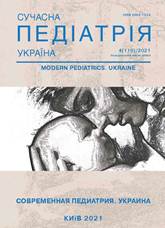Wilson–Konovalov disease: acute onset, course, diagnosis and treatment (clinical case)
DOI:
https://doi.org/10.15574/SP.2021.116.76Keywords:
Wilson-Konovalov disease, etiology, pathogenesis, clinical picture, diagnosis, examination, treatmentAbstract
The article presents information on the main etiology and pathogenesis of Wilson–Konovalov disease, as hepato-lenticular degeneration associated with excessive accumulation of copper in body tissues due to an inherited autosomal recessive defect of a protein that transports copper.
A rare case of the onset and course of the disease in a patient who was examined and treated at the Ivano-Frankivsk Regional Children's Clinical Hospital is described. The main focus is on the acute, atypical onset of the disease, in particular the signs of severe intoxication syndrome caused by manifestations of hepatic encephalopathy, steroid-induced diabetes, anemia of complex genesis, coronavirus disease, pyoderma. The difficulties of diagnosing the disease against the background of delayed manifestation of the main pathognomonic manifestations and the absence of reliable signs of the disease are shown. The clinical picture of this clinical case, features of the course are described, the indicators of the main clinical and laboratory research methods are given, the results of instrumental diagnostic methods and genetic examination methods are shown, both in laboratories of Ukraine and abroad, which confirmed the diagnosis of Wilson–Konovalov disease. The treatment of this clinical case is described in detail not only at the local level but also in the main leading research institution of Ukraine «OHMATDYT» and «National Institute of Surgery and Transplantology named after O.O. Shalimov». Recommendations for further observation and treatment of the child at the place of residence after orthotopic transplantation of the left lobe of the liver from a living family donor.
The research was carried out in accordance with the principles of the Helsinki Declaration. The informed consent of the patient was obtained for conducting the studies.
No conflict of interest was declared by the authors.
References
Aftab A, Walker А, Ashkan К. (2007). Wilson's Disease. Lancet. 3 (369): 397-408. https://doi.org/10.1016/S0140-6736(07)60196-2
Fatemi N, Sarkar B. (2002). Structural and functional insights of Wilson disease copper-transporting ATPase. J Bioenerg Biomembr. 34: 339-349. https://doi.org/10.1016/S0020-1693(02)00949-0
Huster D, Hermann W, Bartels M. (2011). Acute Wilson's disease. Internist. 52: 815-822. https://doi.org/10.1007/s00108-010-2794-z; PMid:21633804
Khilchevska VS, Shevchuk NM, Parfonova IV. (2015). Suchasni diahnostychni mozhlyvosti u veryfikatsii khvoroby Vil'sona-Konovalova u ditei (vlasne klinichne sposterezhennia). Bukovynskyi medychnyi visnyk. 3 (75): 279-281. https://doi.org/10.24061/2413-0737.XIX.3.75.2015.194
Lalioti V, Sandoval I, Cassio D et al. (2010). Molecular pathology of Wilson's disease: a brief. J Hepatol. 5: 1151-1153. https://doi.org/10.1016/j.jhep.2010.07.008; PMid:20832891
Moller L, Ott P, Lund C et al. (2005). Homozygosity for a gross partial gene deletion of the C-terminal end of ATP7B in a Wilson patient with hepatic and no neurological manifestations. Am J Med Genet. 138: 340-343. https://doi.org/10.1002/ajmg.a.30977; PMid:16222684
Stapelbroek JM, Bollen CW, van Amstel JK et al. (2004). The H1069Q mutation in ATP7B is associated with late and neurologic presentation in Wilson's disease: results of a metaanalysis. J Hepatol. 41: 758-763. https://doi.org/10.1016/j.jhep.2004.07.017; PMid:15519648
Sukhareva HV. (2005). Hepatolentykuliarnaia deheneratsyia. Pod red LB Lazebnyk. Yzbrannуe hlavу klynycheskoi hastroеnterolohyy. M: Anakharsys: 199-209.
Voloshyn OI, Prysiazhniuk VP, Kondrevych MI. (2014). Zakhvoriuvannia Vil'sona-Konovalova: suchasnyi pohliad na problemu ta vlasnyi dosvid. Suchasna hastroenterolohiia. 3 (77): 32-36.
Wilson A, Schlade-Bartusiak К, Tison J. (2009). A minigene approach for analysis ATP7B splice variants in patients with Wilson disease. Biochemie. 91 (10): 1342-1345. https://doi.org/10.1016/j.biochi.2009.06.008; PMid:19540904
Downloads
Published
Issue
Section
License
Copyright (c) 2021 Modern Pediatrics. Ukraine

This work is licensed under a Creative Commons Attribution-NonCommercial 4.0 International License.
The policy of the Journal “MODERN PEDIATRICS. UKRAINE” is compatible with the vast majority of funders' of open access and self-archiving policies. The journal provides immediate open access route being convinced that everyone – not only scientists - can benefit from research results, and publishes articles exclusively under open access distribution, with a Creative Commons Attribution-Noncommercial 4.0 international license (СС BY-NC).
Authors transfer the copyright to the Journal “MODERN PEDIATRICS. UKRAINE” when the manuscript is accepted for publication. Authors declare that this manuscript has not been published nor is under simultaneous consideration for publication elsewhere. After publication, the articles become freely available on-line to the public.
Readers have the right to use, distribute, and reproduce articles in any medium, provided the articles and the journal are properly cited.
The use of published materials for commercial purposes is strongly prohibited.

